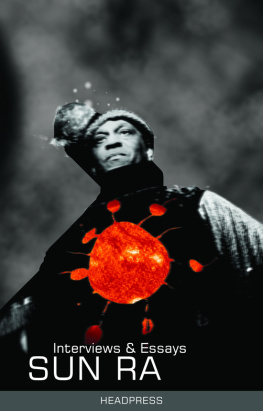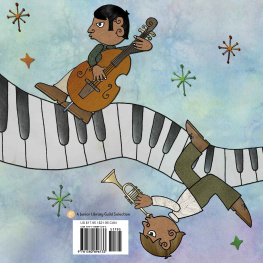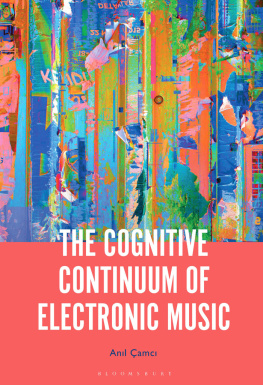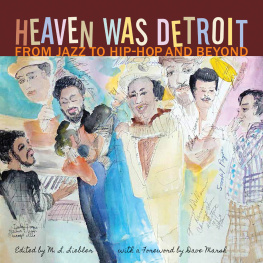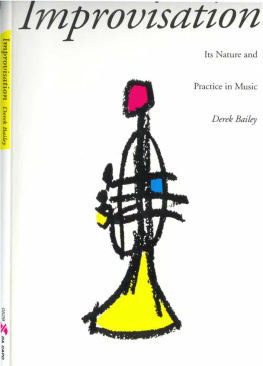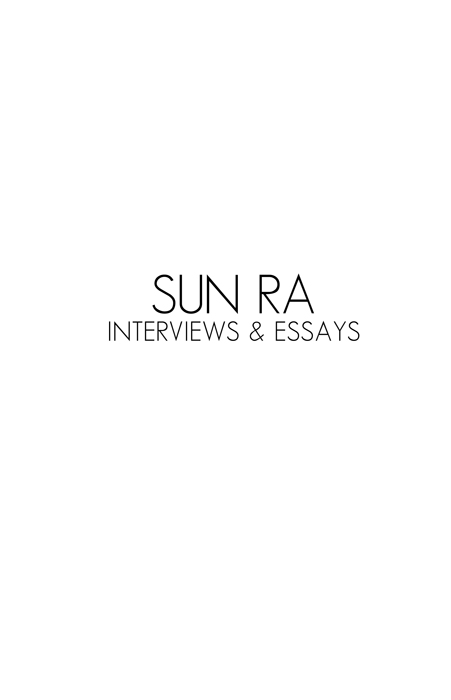Interview with Sun Ra, Detroit Sun, 1966
Sun Ra in New York City, Oakland & Philadelphia
Sun Ra & MC5 at the Grande Ballroom, Detroit, 2009
Sun Ra at the Ann Arbor Blues & Jazz Festival, 1972
Grand Rapids, Michigan, 1999
A Conversation with Michael Ray
Sun Ra & His Arkestra at the Detroit Jazz Center, 1980
The Sun Ra Arkestra under the direction of alto saxophonist Marshall Allen
A Conversation with Wayne Kramer, London, June 2008
Brain-Tingling Space Jazzby Ian Harrison
Live from Berlin: The Sun Ra Tribute Project
The Cry of Jazz & Space Is the Place
New Orleans Times-Picayune, 1993
Photos & Comicsfollowing pages
Sonnys Last Songby Mat Colegate & Dan White
Scrapbook
BY WAY OF AN INTRODUCTION
by Peter dennett
I am a musician, but Im another type of musician.
I use music as a medium to talk to people.
Im not a minister, Im not a philosopher, Im not a politician, Im in another category.
Music is a language, you see, a universal language.
Sun Ra
S UN RA (1914-93) was a major black musician and bandleader, a groundbreaking innovator of immense and extraordinary vision, the cornerstone of experimental jazz whose mythology and intergalactic narrative navigated between Ancient Egypt and outerspace.
Sun Ras performances with a large ensemble of musicians and dancers incorporated everything from thirties big band swing to experimental funk and synthesizer pieces. He was also a master pianist whose published output exceeded 180 albums recorded for many American and European jazz labels and he toured extensively with his various ensembles between 1956 and 1993. He also did cover versions of Walt Disney tunes and recorded a couple of sides for a toy company, as well making films and documentaries about his philosophy and vision.
Sun Ras music is associated with his musical navigation toward free jazz and his poetry toward cosmology and Egyptology. Sun Ra worked within the traditional established African American expressive traditions to develop a distinct compositional style and language fusing elements of the blues, ragtime, and spirituals with experimental electronic instruments, rhythm machines and invented instruments to present new musical dimensions. Ra was a cosmic guide through black musical traditions, a twenty first century Tonal Guide to Times Tomorrow.
Sun Ra is arguably one of the most influential and important of all twentieth century composers. Ra was a sonic explorer in revolutionary new forms of music: Art Forms of Dimensions Tomorrow. His extraordinary work and time on this planet have yet to be fully appreciated.
SUN RA
by Amiri baraka
I PASSED THROUGH RAS ORBIT when the Arkestra first arrived from Chicago into the Loisaida (pre Latino street signs), early sixties. They swept in, with tales and a frantic grapevine of every which observation.
The Weirdness, Outness, Way Outness, Otherness was immediate. Some space metaphysical philosophical surrealistic bop funk. Some blue pyramid home nigger southern different color meaning hip shit. Ra. Sun Ra.
Then they put on weird clothes, space helmets, robes, flowing capes. They did rituals played in rituals, evoked lost civilizations, used strangeness to teach us open feeling as intelligence.
In those cellars and lofts, Sun Ra spun a cosmic metaphor. He was a philosopher musician. He used music as language, and image.
His was an historical music. He began himself before he played with Fletcher Henderson, playing alternate piano in the orchestra when Fletcher conducted. In recent years he even brought Fletcher and Duke Ellington back with a sweetness and contemporary restatement that was thrilling.
Ra was so far out because he had the true self-consciousness of the Afro-American intellectual artist revolutionary. He knew our historic ideology and socio-political consciousness was freedom. It is an aesthetic and social dynamic. We think it is good and beautiful!
Sun Ras consistent statement, musically and spoken, is that this is a primitive world. Its practices, beliefs, religions are uneducated, unenlightened, savage, destructive, already in the past.
Thats why Ra left and returned only to say he left. Into the Future. Into Space. He played Interplanetary Music. He described Angels and Demons at Play. From his Heliocentric vision, Ras music unfolded; it was always, it seemed, always there. What it was.
African American Review, Vol. 29,1995
SUN RA VISITS PLANET EARTH
by John Sinclair
People say Im Herman Blount, but I dont know him. Thats an imaginary person, he never existed. I have a sister and brother named Blount, but their father died 10 years before I arrived on the planet. Hes not my father. If I tried to do anything with the name Sonny Blount, I couldnt... Im not terrestrial, Im a celestial being.
Sun Ra, from John Dilibertos liner notes to
Sound Sun Pleasure (Evidence ECD-22014)
T HE AFRICAN AMERICAN musical genius known as Sun Ra was a delightfully unique individual whose startlingly innovative Arkestra and provocative persona generated considerable myth and controversy during most of the second half of the twentieth century.
The legendary pianist, composer, bandleader, performance artist, musical pioneer and space philosopher was born Herman Blount in 1914 in Birmingham, Alabama, and was known to family and friends as Sonny.
He attended Alabama A&M and played with bands around the South before settling in Chicago after World War II, where he worked at the Club DeLisa as second pianist and arranger with the Fletcher Henderson Orchestra during 1947-49.
By the turn of the fifties Sonny Blount was writing music for the shows, rehearsing the chorus line, and leading the relief band at the Club DeLisa two nights a week.
He formed his own trio to back up vocalists, instrumentalists and floor-shows in local nightspots, soon landing a regular gig at Budland supporting visiting stars like Sarah Vaughan, Johnny Guitar Watson, LaVerne Baker, Dakota Staton and comedian George Kirby.
AT THIS POINT THE PIANIST began his long association with Chicago philosopher/businessman Alton Abraham, a pragmatic mystic who would become his mentor, personal manager, booking agent, recording supervisor and business partner for the next quarter century.
With Abrahams guidance Herman Sonny Blount took the name Le Sun Ra and began to reveal an elaborate, unprecedented cosmic philosophy through his compositions, song titles, poetry, wild costumery, and an innovative, ever-expanding musical ensemble first called the Solar Arkestra.
The Arkestra, billed as playing Music from tomorrows worldMagic Music of the spheres, began its spectacular fifty eight year lifespan in 1952 in the form of a six-piece jazz combo organized to showcase Sun Ras original compositions, arrangements and multi-media performance concepts.
There are photos of the Herman Blount Octet in Chicago in the mid fifties, identified as Pat Patrick (alto and baritone sax), John Gilmore (tenor sax), Dave Young (trumpet), Julian Priester (trombone), Richard Evans (bass), Bob Barry (drums), Jimmy Herndon (percussion) and Herman Blount (piano, leader).
With Abraham as its booking agent, early editions of the band worked five nights a week at Budland in the Pershing Hotel and played the Sunday dances at Roberts Show Club on South Parkway.

